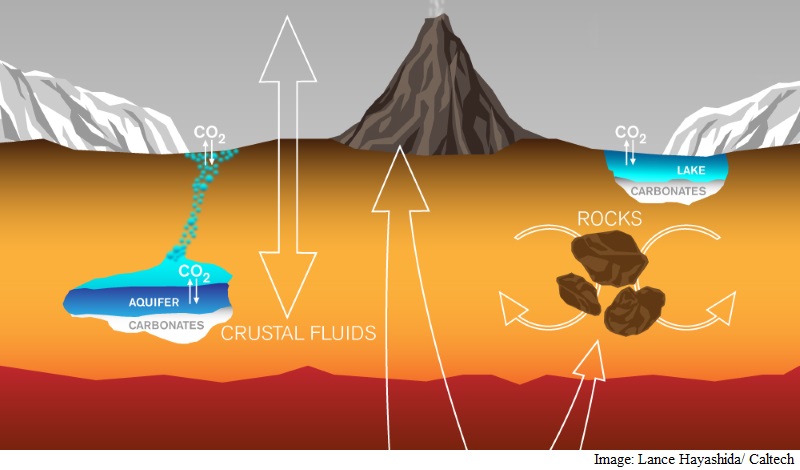- Home
- Science
- Science News
- Carbon From Mars Escaped Into Atmosphere Due to UV Rays, Claims Study
Carbon From Mars Escaped Into Atmosphere Due to UV Rays, Claims Study

They suggest that 3.8 billion years ago, Mars might have had a moderately dense atmosphere.
Such an atmosphere with a surface pressure equal to or less than that found on Earth could have evolved into the current thin one.
"Our paper shows that transitioning from a moderately dense atmosphere to the current thin one is entirely possible," says postdoctoral fellow Renyu Hu from California Institute of Technology (Caltech).
The solar wind stripped away much of Mars' ancient atmosphere and is still removing tons of it every day.
There are two possible mechanisms for the removal of the excess carbon dioxide.
Either the carbon dioxide was incorporated into minerals in rocks called carbonates or it was lost to space.
One way carbon dioxide escapes to space from Mars' atmosphere is called sputtering, which involves interactions between the solar wind and the upper atmosphere.
Nasa's MAVEN (Mars Atmosphere and Volatile Evolution) mission has yielded recent results indicating that about about 100 grams of particles every second are stripped from today's Martian atmosphere via this process.
Sputtering slightly favours loss of carbon-12, compared to carbon-13, but this effect is small.
The Curiosity measurement shows that today's Martian atmosphere is far more enriched in carbon-13 in proportion to carbon-12 than it should be as a result of sputtering alone, so a different process must also be at work.
Hu and his co-authors identify a mechanism that could have significantly contributed to the carbon-13 enrichment.
The process begins with ultraviolet (UV) light from the Sun striking a molecule of carbon dioxide in the upper atmosphere, splitting it into carbon monoxide and oxygen.
Then, UV light hits the carbon monoxide and splits it into carbon and oxygen.
Some carbon atoms produced this way have enough energy to escape from the atmosphere, and the new study shows that carbon-12 is far more likely to escape than carbon-13.
There are three naturally occurring isotopes of carbon: 12, 13 and 14.
Modeling the long-term effects of this mechanism, the researchers found that a small amount of escape by this process leaves a large fingerprint in the carbon isotopic ratio.
That, in turn, allowed them to calculate that the atmosphere 3.8 billion years ago might have had a surface pressure a bit less thick than Earth's atmosphere today.
"This solves a long-standing paradox," added Bethany Ehlmann of Caltech and Nasa's JPL in a paper published in the journal Nature Communications.
For the latest tech news and reviews, follow Gadgets 360 on X, Facebook, WhatsApp, Threads and Google News. For the latest videos on gadgets and tech, subscribe to our YouTube channel. If you want to know everything about top influencers, follow our in-house Who'sThat360 on Instagram and YouTube.
Related Stories
- Galaxy S24 Series
- MWC 2024
- Apple Vision Pro
- Oneplus 12
- iPhone 14
- Apple iPhone 15
- OnePlus Nord CE 3 Lite 5G
- iPhone 13
- Xiaomi 14 Pro
- Oppo Find N3
- Tecno Spark Go (2023)
- Realme V30
- Best Phones Under 25000
- Samsung Galaxy S24 Series
- Cryptocurrency
- iQoo 12
- Samsung Galaxy S24 Ultra
- Giottus
- Samsung Galaxy Z Flip 5
- Apple 'Scary Fast'
- Housefull 5
- GoPro Hero 12 Black Review
- Invincible Season 2
- JioGlass
- HD Ready TV
- Laptop Under 50000
- Smartwatch Under 10000
- Latest Mobile Phones
- Compare Phones
- Motorola Edge 50 Fusion
- Oppo A1i
- Oppo A1s
- Motorola Edge 50 Ultra
- Leica Leitz Phone 3
- Moto G64 5G
- Moto G04s
- iQOO Z9 Turbo
- Asus ZenBook Duo 2024 (UX8406)
- Dell Inspiron 14 Plus
- Realme Pad 2 Wi-Fi
- Redmi Pad Pro
- Cult Shock X
- Fire-Boltt Oracle
- Samsung Samsung Neo QLED 8K Smart TV QN800D
- Samsung Neo QLED 4K Smart TV (QN90D)
- Sony PlayStation 5 Slim Digital Edition
- Sony PlayStation 5 Slim
- Onida 1.5 Ton 3 Star Inverter Split AC (IR183TSN)
- Haier 1.5 Ton 3 Star Window AC (HWU18TF-EW3BE-FS)

















